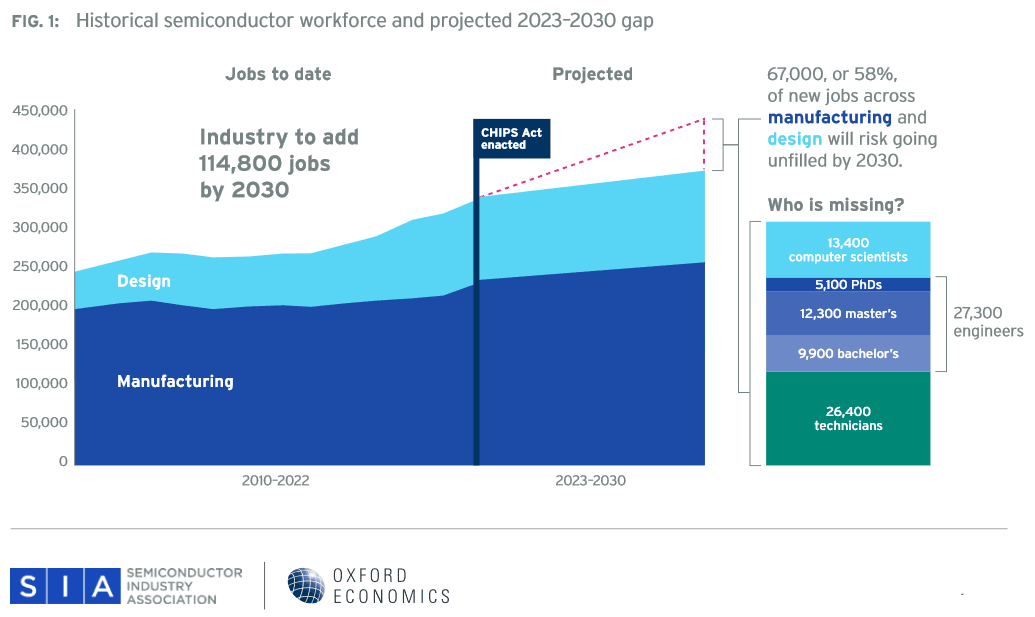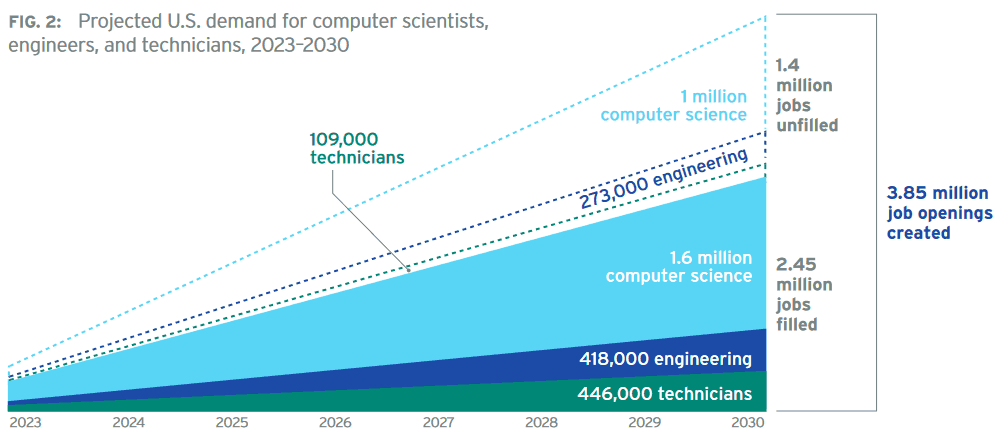U.S. Chip Industry Labor Shortfall Could Reach 67,000 Workers by 2030
Country will be roughly 67,000 workers short of requirements by 2030, says industry report.

In a report published by the Semiconductor Industry Association (SIA) today, it was estimated that there will be a shortfall of 67,000 workers in the industry, by 2030. Key roles that will be difficult for US-based chipmakers to fill include technicians, computer scientists, engineers. Thus, SIA has devised a three point action plan to address the talent gap.
The US has big ambitions for its domestic semiconductor industry, even going so far as encouraging foreign investment from the likes of Samsung and TSMC. The enactment of the landmark CHIPS and Science Act of 2022 means that the US will be responsible for a significant share of global semiconductor output, going forward. However, the problems we are already seeing, regarding the lack of qualified and interested staff, look set to get worse.
SIA expects the semiconductor industry’s workforce will grow by nearly 115,000 jobs by 2030. That means the total workforce of roughly 345,000 people today should expand to 460,000 by the end of the decade to keep pace. The labor market is going to struggle to keep up, though. Making clear the core issue, SIA says that current degree completion rates mean that roughly 67,000 - or 58% of projected new jobs - will go unfilled.
This insufficient qualified labor problem isn't isolated to the semiconductor industry in the US. Looking at the wider jobs market for a moment, SIA says that by the end of the decade an estimated 3.85 million additional US jobs requiring proficiency in technical fields will be created. Of these about 1.4 million are at risk of being unfilled. These are huge numbers, and for industries like semiconductors, which have been judged to be one of strategic importance to the country, the issue is most concerning.
So, what is to be done to address the gap between the number of skilled chip industry workers expected to be needed, and the number that are expected to become available? SIA has a three point plan, and we have quoted the bullet points verbatim, below.
- Strengthen support for regional partnerships and programs aimed at growing the pipeline for skilled technicians for semiconductor manufacturing and other advanced manufacturing sectors.
- Grow the domestic STEM pipeline for engineers and computer scientists vital to the semiconductor industry and other sectors that are critical to the future economy.
- Retain and attract more international advanced degree students within the US economy.
Hopefully, the above will be heeded by national and local government, and key industry players, and prove to be enough to help fill the talent gap - or if not it at least make things more manageable.
Some of the news coming out of TSMC's big venture into the US, propelled by the CHIPS Act, isn't very encouraging for those who might be interested in working in the industry. For example, in June, we reported on TSMC chairman Mark Liu saying workers in the industry should expect long shifts, and have their passion for the industry tested by the work environment. This came after news that TSMC was struggling to hire local workers in Arizona, so was seeking more Taiwanese migrants to fill the gaps.
Get Tom's Hardware's best news and in-depth reviews, straight to your inbox.

Mark Tyson is a news editor at Tom's Hardware. He enjoys covering the full breadth of PC tech; from business and semiconductor design to products approaching the edge of reason.
-
Giroro People should be lining up around the block for these jobs.Reply
All you need is a rare 6-year degree, 10-20 years experience... and a willingness to live in company housing, 80-hour always-on-call work week, be under constant pressure that the company openly wants to relocate your job back home to asia with zero-notice, and accept a salary 30% below what a person with those qualifications would make working literally anywhere else.
I can't see a single reason why professors would ever teach their students to avoid the semi industry like the plague. It's baffling, really. -
PEnns ReplyGiroro said:People should be lining up around the block for these jobs.
All you need is a rare 6-year degree, 10-20 years experience... and a willingness to live in company housing, 80-hour always-on-call work week, be under constant pressure that the company openly wants to relocate your job back home to asia with zero-notice, and accept a salary 30% below what a person with those qualifications would make working literally anywhere else.
I can't see a single reason why professors would ever teach their students to avoid the semi industry like the plague. It's baffling, really.
^^^
This!!
And then all the whining "we can't find employees willing to work"..... -
rabbit4me2 People don't want to work right now, there waiting for that good ole stimulus check again. !!! Job are there, people are there, so this article is 100 in disagreement!Reply -
bigdragon 24/7 on-call work weeks, 60+ hours a week, and only 80 hours of PTO -- of which you are penalized and looked down upon for using -- each year? Experienced and expert workers don't tolerate that kind of crap. SIA needs to fix working conditions at their member companies. A lot of the talent that was here left for Europe for better conditions.Reply -
Jaxstarke9977 I'd gladly work in the chip industry and get out of the tungsten carbide manufacturing plant I'm in now. But I'm not moving to a high-tax, high cost of living state/city to do it.Reply -
rtp While we are discussing "people not wanting to work" vs. reality, how about:Reply
Companies have no-references policy and will only "verify employment" via fax to lawyers on retainer, which requires your SSN and signed release, BUT ...... Those same companies --- and virtually all corporations --- use recuritment sites which have no means of attaching documents, and no fields where people can type verification info, while JavaScript enforces content of fields very strictly! (So you can't even type said information into what looks like a free-form text field ... i.e. name accepts no digits, address field only accepts digits at the start of text and then only text.)Meanwhile, "Mom and Pop" have never heard of such things and don't even own a fax, and they're not going to spend their time or money faxing by other means when summer help is otherwise lining up at the door!
(NOT) sorry for the rant!

